Content [show]
They have a great advantage for working gardeners who cannot come to their plots during the week. The so-called "Sunday" amateur gardeners visit their plots on weekends, water them and limited to duty care for plants. The formation of peppers in the greenhouse, as such, is not of interest to them.
What is it for?
With a serious approach to the cultivation of different varieties of sweet peppers (about the features of growing bell peppers in a greenhouse, read the link), the question arises of increasing its yield. Pepper in a greenhouse is a bush culture, and the correct formation of a bush significantly affects on the ability to bear fruit and fruit ripening rate.
In areas of the middle lane, where summers are shorter and cooler, peppers have to be grown mostly in greenhouses. Under these conditions, artificial limitation of the appearance of new ovaries allows for the maturation of those that already exist.
Moreover, it is possible to purposefully influence plants in order to direct their efforts either to increase the number of fruits, or to enlarge them. Usually, of course, interest in the quality of the crop wins. Farmers and Experienced gardeners do not neglect this opportunityespecially when it comes to tall varieties.
If, in addition to peppers, you have cucumbers planted in a greenhouse, then you can find out about the formation of their play, as well as the compatibility of growing with peppers, on our website.
Meaning for different varieties
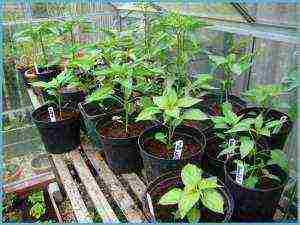 Tall varieties of peppers cannot be grown without forming a crown of a bush and tying each branch. Medium-sized varieties can be satisfied by removing the lower shoots and barren twigs.
Tall varieties of peppers cannot be grown without forming a crown of a bush and tying each branch. Medium-sized varieties can be satisfied by removing the lower shoots and barren twigs.
This plant gets rid of unproductive costs for their maintenance, as well as improving the illumination and ventilation of all elements of the bush.
If the variety is undersized, and even more so dwarf, then it is not worth forming at all. Unless only in the case of too dense planting of seedlings. This is entails increased foliage density, is fraught with plant diseases and slowing down of their development. In this case, willy-nilly, you will have to deal with the formation of the crown of the bushes, otherwise the harvest will be unimportant.
How to form a bush correctly?
The yield of peppers grown in the greenhouse directly depends on how well the bushes are formed. For different varieties apply various formation options... Also, the nature of the formation depends on whether the greenhouse is heated or not.
Bushes growing in open ground or in an unheated greenhouse can grow up to 60 cm. If the greenhouse is heated, the bushes will be taller and the fruits can be grown larger.
Pepper bush formation includes into themselves such stages:
- determination of the correct planting scheme;
- removal of the crown bud, one or more;
- pinching, or removing excess shoots;
- getting rid of the plant from excess leaves and sterile shoots;
- pinching of skeletal branches.
Attention: operations within the framework of the formation of pepper bushes are only permissible for completely healthy plants... Working with pruners or scissors without disinfecting them after each plant, you can, without noticing it, transfer the disease from a diseased plant to healthy ones.
Let's consider the stages of the formation of a bush in more detail.
Pepper planting scheme
Usually on a package of pepper seeds there is a recommendation regarding the planting scheme for this variety. It is determined, as a rule, on the basis of the size to which the bush can grow.
How to distribute the shoots when planting in a greenhouse, you need to think in advance. If the variety is undersized, then with an optimal planting scheme, it will not have to be pinned. But a tall variety will not avoid this procedure in any case.
Moreover, the features pinching straight depend from what what is the scheme for the plants... As a matter of fact, each greenhouse has its own personality, so you need to look for the optimal planting scheme specifically for your greenhouse. You have to experiment a little, but it's worth it.
Removing the crown bud
The crown bud (or crown flower) is called the flower ovaries that form in the first fork on the main stem - the stem of the pepper. Pepper grows as one stem first, up to about 15-20 cm, it depends on the variety. It then starts branching and the crown bud is immediately removed to ensure proper branching. This provides improved nutrition for the ovaries located above the fork.

Stepping
The purpose of the operation is to redistribute juices and nutrients in order to improve the quality of fruiting. Pepper, as one of the crops most commonly grown in greenhouses, needs careful shaping of the bush... And pinching is a tool for this formation.
You need to start using this tool early so that the bush forms the way you want. Grasshopping consists in the removal of lateral shoots that appear during the growth of the stem.
Wherein flowers are also removedwho are interpreted as sterile, and extra leaves... Why waste plant strength and nutrients? So they remove everything unnecessary, following the principle of expediency.

This is the order in which it is done. First, as already mentioned, the stem appears. 2-3 shoots are left on it, the strongest, of those that are released from the fork with the crown bud. These are shoots of the 1st order. They are called skeletal, because they really play the role of the skeleton of the entire bush as a whole.
For all other shoots, the top is cut off, which is the point of growth. Usually at this time there are already 10-12 leaves on the bush.
Skeletal twigs are subject to the same branching ability. At the branching point, the so-called "fork", a bud is also formed at one time. We act according to the same principle with the fork: we leave a strong and healthy shoot, we pinch the weak ones.
Cut off the shoot, stepping back up from the first leaf and flower bud. The bud usually stays on the main stem. Total it is recommended to leave 15-25 ovaries on one bush, then large fruits will turn out from them.
When removing the shoot, it is necessary to leave one leaf, since the nutrition of the ovary located under it depends on it.
Each subsequent division is subjected to a similar treatment: the strongest shoot is left, and the rest are removed after the first leaf. The bush should have the following structure:
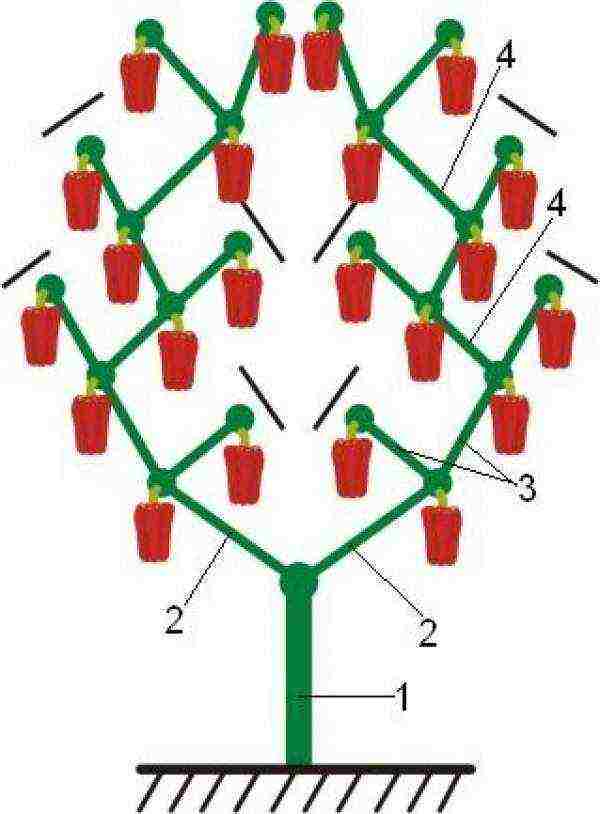
Figure 1 - Scheme of the structure of a pepper bush grown in a greenhouse.
1 - main stem, or stem;
2 - shoots of the 1st order;
3 - shoots of the 2nd order;
4 - skeletal branches
Removal of excess leaves and sterile shoots
On the main stem, below the bifurcation, unnecessary shoots may appear and leaves. They must be removed immediately, and for this it is necessary to inspect the pepper bushes more often. It is also necessary to remove the leaves that shade the light of the ovaries and consume the juices wasted.
If there is little light, then the fruits may well not set at all, even if flowering occurred and was abundant. therefore extra leaves necessary decisively cut with an unwavering hand.
Unhealthy and damaged leaves should also be removed immediately. At the same time, it does not matter at all where exactly they grew up. Sometimes at the cost of timely removal of diseased leaves manages to save the whole bush.
When the fruits on the first cluster reach the level of technical ripeness, the leaves on the stem of the pepper are cut off. Similarly, when the fruits on the second cluster reach the same level of maturity, the leaves growing under it are cut off.
And so on, according to the same scheme: we remove the leaves under the fruits. You just need to remember that the last such removal is done no later than a month and a half until the planned completion of harvesting. We must finally leave the plant alone and let it run at full strength in the season finale.
Attention: in no case should you remove all the leaves at once, this will shock the plant. You can cut off 2 sheets at a time, no more, so that a fatal outcome does not happen.
Pinching skeletal branches
Having taken care of the formation of the proper amount of fruits on the bush, it is necessary to provide conditions for their ripening. This requires stop the process of further formation of ovaries, then the powers of the plant will not be diffused.
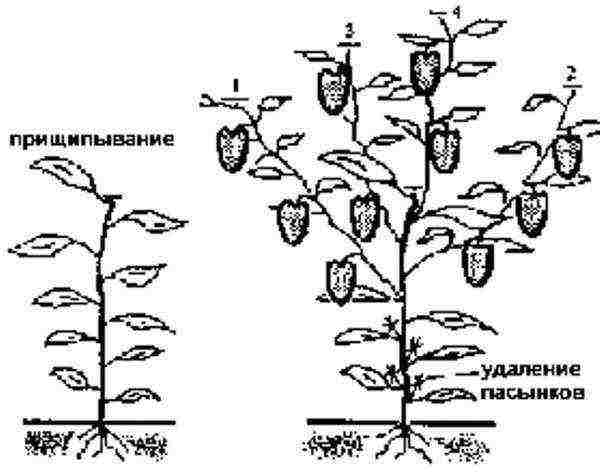
In pursuit of these goals, we make the last pinching one and a half months before the expected end of the season: cut off the tops of all skeletal branches... By eliminating the points of growth, it is possible to achieve the concentration of the efforts of the bush on the maintenance of the existing fruits.
Just at this time, a massive formation of peppers in the greenhouse takes place, and the measures taken allow the fruits to ripen much faster, to turn out ripe, with excellent taste.
Having tried to grow bell peppers in his greenhouse, the savvy gardener will understand that the issue of forming a bush should not be neglected... How this task is solved depends on what kind of harvest he will receive. Either plentiful, with selective and sweet fruits, or unimportant, with a large number of small fruits that do not shine either in appearance or taste.
Bell peppers are our favorite vegetable. It is not just tasty, it is a storehouse of vitamins, of which there are up to 30, as well as other vital substances. Sweet pepper has a wonderful property. It retains many useful qualities in dry and ground form and practically does not lose them during canning.
Formed vegetable pepper bush
Each gardener, growing vegetables on his site, tries to get a large harvest and, not knowing all the basics of agronomy, often spends his energy, time and money ineffectively.
Trying to grow a large crop, the owner intensively feeds the plants, watering them to exhaustion, poisoning them, protecting them from diseases and pests. Of course, these techniques give positive results, but there are ways that will provide a high yield at a significantly lower cost of money, time and health. This technique includes the formation of a pepper bush, as tomatoes, cucumbers, zucchini and other vegetable crops are formed.
Is the formation of sweet peppers always necessary?
Experienced vegetable growers consider the formation of sweet peppers to be a necessary technique to increase the yield and size of the fruits. Beginners practically do not use it, believing that even without the formation of a bush, pepper will give a large harvest if heat, lighting, watering and feeding are provided.
For growers who ignore the formation of the sweet pepper bush, breeders offer varieties and hybrids, when growing which you can do without this technique. The following undersized, weakly branching varieties of pepper and hybrids do not need to be formed.
- Weakly branching peppers: Florida, Barguzin, Topolin, Zodiac, Alyosha Popovich, Bagration, Lumina (Belozerka), Dobryak, Victoria, Bogatyr, Ilya Muromets, Swallow, Gift of Moldova, Dobrynya Nikitich and others.
- Weakly branching pepper hybrids: Pinocchio F1, Claudio F1, OthelloF1, Goodwin F1, Gemini F1, Maxim F1, Mercury F1 and others.
For low-growing bushes (40-65 cm) of pepper, it is enough to cut out weak, sterile and growing inward shoots. Tall ones form a large vegetative mass that takes away nutrients necessary for plants to develop fruit.Let's try to figure out what opportunities the gardener misses without using the method of forming tall varieties of sweet peppers, which significantly increases the yield of the vitamin product.
The tall ones include peppers, the bushes of which reach a height of 100-200 cm. The densely overgrown aerial mass creates ideal conditions for the development of diseases and pests. They must be thinned out in order to improve ventilation, lighting, and nutrition. Therefore, all tall varieties and hybrids of peppers need to form bushes.
Pepper formation is not a one-time pruning of vegetative shoots or pinching of leaves. Formation includes several techniques and is carried out in several stages.
Thickened bush of vegetable pepper
Rules for the formation of sweet peppers in greenhouse culture
In the limited space of protected ground, only correct formation can increase the yield and size of pepper fruits. In an optimal greenhouse environment, the bush will grow magnificently to the detriment of the development of generative organs. As a rule, in a greenhouse, the culture is grown through seedlings.
Seedling period
When growing pepper seedlings on their own, the formation of a bush begins when the seedling reaches 15-20 cm in height. Usually at this height, the stem of the peppers begins to branch, dividing into 2 branches. A bud appears at the fork of the branch, which can bloom before being transplanted into the greenhouse. This bud is called the crown bud. It is usually removed to allow further branching of the pepper bush. Each branch will form fruits and thus the overall yield will increase.
When self-obtaining pepper seeds, the crown bud is left on 1-2 bushes. It forms the healthiest seeds that are used for further propagation.
Crown bud pepper fruit on a first-order fork
Formation of a bush of sweet pepper in a greenhouse
When transferred to a greenhouse, the pepper is planted so that it remains possible to increase the volume of the bush by 2-3 branches. The planting scheme for varieties and hybrids with high bushiness can be 40-50x70-80, i.e. 2-5 or 3-6 pieces per sq. m. If the bushiness is average, then per sq. m. m planted from 6 to 8 bushes of pepper.
The formation of a pepper bush consists of pinching, removing excess sterile shoots and cutting. After planting and engraftment, the bushes are inspected so that they are healthy and free of pests. The sterile lower shoots and leaves that are on the trunk before the first fork are removed, providing the bushes with normal ventilation and lighting.
Pepper twigs formed after branching are called lateral. These are branches of the first order, or skeletal. Each side branch first grows with a central stem that has leaves. Shoots appear at the base of the petioles of these leaves (in the axil). These are the stepsons. They are removed by pinching.
Diagram of the method of forming a bush of pepper in two stems
The central branch of the first order pepper also branches into 2 shoots. These are shoots of the second order. The stronger one is left. It is considered skeletal and must have the strength to support the rest of the higher shoots. Leaves, buds or flowers / fruits are left on it. The second shoot of the second order of the pepper is usually weaker. It is pinched, leaving the fruit and the leaf.
Skeletal shoot of the 2nd order, in turn, is divided into 2 branches. These are tier 3 branches. They do the same with them. Allocate the main, or skeletal. It grows and develops normally. In the axils of its leaves, stepchildren are removed. The yellowed pepper leaves are examined and removed from the stem and skeletal branches. The second shoot (weaker) of the third order is pinched over the first flower bud. Be sure to leave a leaf that will provide nutrition for the ovary.
The same process is done on the first-order skeletal shoot of the second branch (remember, the first fork). This is the formation of a bush in 2 stems.If not one, but 2 lateral shoots are left on the pepper stem, then the skeletal branches of the first order will not be 2, but 4. One is removed. 3 stems remain. Formed according to the above scheme.
If it is planned to form the pepper by the stem method, it is necessary to pre-install the trellis so that each order of branches is attached to the transverse fastening. The mass of fruit growing can break fragile branches. Do not forget, while examining the pepper bush, to remove the shoots without flowers (fattening, sterile). Do not regret pinching one of the shoots at the fork and picking off old yellow (non-working) leaves.
On each skeletal stem of the 1st, 2nd, 3rd and other orders below the branching, leaves and additional shoots appear over time (the stems do not remain naked, they are overgrown with leaves, shoots). They must be removed, but gradually. No more than 2 leaves a day. Moreover, first of all, they remove the leaves that shade the ovaries of the pepper.
This operation is repeated until the bushes reach the ceiling of their height of 1.0-1.2 m. The top is cut off in order to stop growing in height and redirect nutrients to the underlying ovaries and fruits. 1.5 months before the end of the harvest, the tops of the skeletal branches of all orders are cut off to stop growth and redirect nutrients to young fruits.
Usually, 20-25 large thick-walled fruits are left on the formed pepper bushes. On unformed overgrown bushes, by autumn it will be full of small ovaries and fruit trees. In this case, the full-fledged yield of pepper will turn out to be lower and practically, especially of mid-season varieties, without fruits in their biological ripeness.
Pepper bush formed into two stems
Formation of a bush of sweet pepper in the open field
When growing peppers in open ground, only tall varieties and hybrids are subject to formation. In medium-sized plants, sterile fattening shoots, lower shoots and stepsons are subject to removal in order to provide the bush with normal lighting and ventilation. Low-growing peppers do not need shaping. Curves, broken off shoots growing inward are to be removed. On medium and low-growing bushes of pepper, to enhance lateral branching, pinching of the central shoots is carried out. The total number of fruitful shoots of pepper does not exceed 4-6, and the number of fruits, depending on the variety, is 15-25.
Tall plants when grown outdoors must be loaded with side shoots. To force the plant to bush, pinch the top on the main stems at a level of 25-30 cm from the soil level and remove the crown buds. The basis of the pepper bush will be 4-5 skeletal shoots of the first order. The rest are removed.
The rest of the formation process is associated with pinching off excess shoots. 3-5 strongest shoots are left, formed from the fork of the shoot. At each next branch of the bush, approximately the same number of shoots are left, the rest are removed. It turns out a lush bush. When a sufficient number of fruits are formed on the pepper bush, the skeletal branches are pinched or cut off the top. Pepper fruits left on the bush will gain mass intensively, and new ones will stop tying. The energy of the growth processes will switch to the ripening of already formed fruits. During this period, new leaves and shoots will continue to grow.
Pinching and removing the pepper leaves will provide a comfortable crop environment. The entire growing season of sweet pepper must take into account the weather conditions. If the summer is dry, then it is better not to remove the lower leaves. They will cover the soil from excessive heating. In a wet and rainy summer, on the contrary, the lower part of the bush must be exposed (mainly at the level of the trunk) so that excess moisture does not stagnate, provoking fungal and bacterial diseases.
Thus, pepper shaping, timely removal, pinching and pruning will help you get a higher and better yield of your favorite peppers.
Good afternoon, I planted vegetables in the greenhouse for the first time. I would like to know what kind of pepper care is needed in the greenhouse; is the formation of a bush a necessary procedure when growing a crop?
To get an early harvest of vegetables indoors, basic maintenance procedures must be followed. Greenhouse greenhouse maintenance, bush formation, fertilization, watering, etc. will help increase yields in conditions where the growing cycle of the plant is shortened.
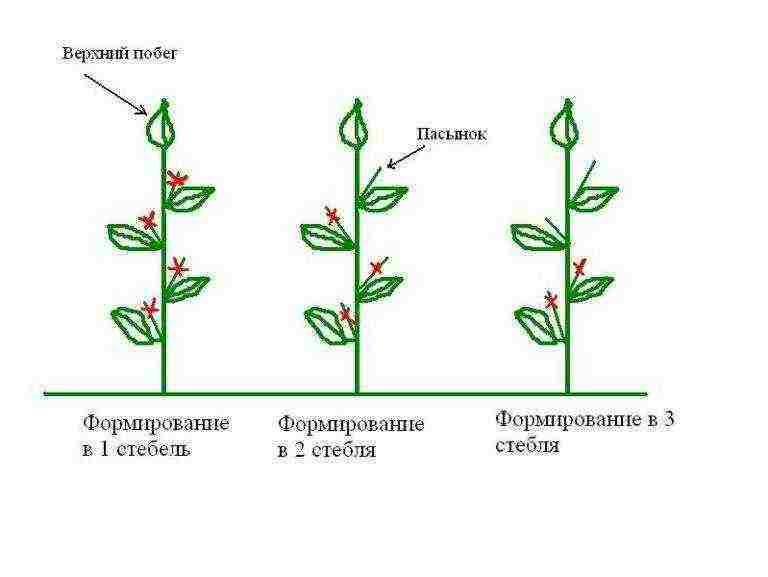
In greenhouses that are not equipped with additional lighting and heating, it is impossible to create a microclimate that would be similar to the nature of South America. This part of the world is the birthplace of bell pepper. It is possible to prevent an undesirable event, that is, not to be left without the expected harvest. To do this, you need to adhere to the recommendations of experienced gardeners.
The main indicators that affect the growth of heat-loving pepper include: temperature, watering, top dressing and timely loosening of the soil. It is necessary to water the pepper every other day, each adult planting requires 1.5-2 liters of warm water. The cultivated vegetable is fed with fertilizers such as nitrogen, calcium, potassium and phosphorus. In addition, cow dung and herbal infusion will be a good help for the nutrition of the crop.
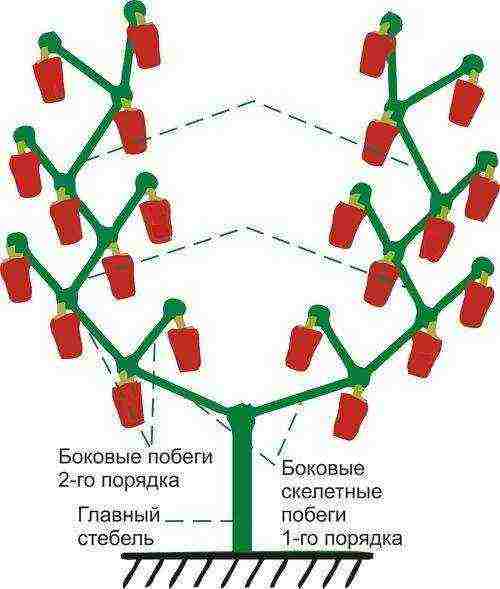
Pinch and remove excess shoots on pepper bushes more often in tall plants, medium-sized varieties relieve only of barren flowers and lower shoots. Dwarf plantings should not be formed, because they bear fruit well without this procedure.
Rate the article:
(1 vote, average: 5 out of 5)
The formation of a bush is the most important agricultural technique when growing pepper, since a large harvest depends on it.
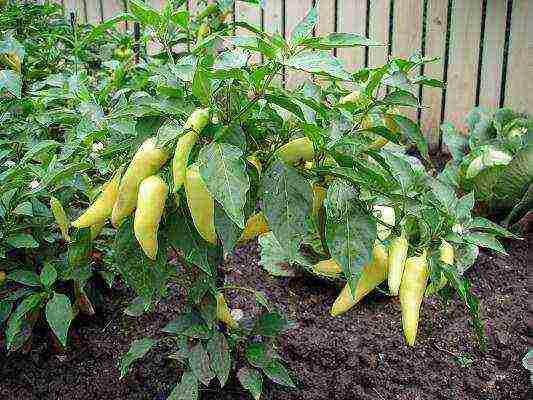
The formation of plants in 2, 3 or 4 stems depends on the planting scheme and the length of the growing cycle.
Pepper is a bush plant. Shaping helps to increase the size of the fruit and accelerate its ripening. This is especially important for tall varieties.
The need for formation 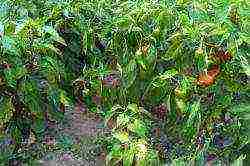
The amount of harvest will depend on the quality of the formation of the pepper bushes.
Pepper is one of the most popular crops grown in the greenhouse. The formation of a bush can be carried out in several ways, it all depends on the variety of pepper. If it is grown in an unheated greenhouse or in the open field, then the bushes grow up to 60 cm in height, in a heated greenhouse they will be larger.
When the seedlings become 15 centimeters high, the apical growth points must be removed from it. This will help strengthen the branching and shape the bush.
It is formed into two, three or four stems. This will depend on the scheme according to which the pepper is planted in the greenhouse, as well as on the growing period. You should not allow a large density in the garden. This can cause disease, as well as reduce yields and impair the quality of the fruit. To regulate the ground mass of plants, pruning is done. Prepared in this way, they begin to bear fruit much earlier and give a greater yield.
It should be noted that formation is permissible only on healthy plants. If the vegetables in the greenhouse are affected by any disease, no work should be done with them.
Back to the table of contents
Stages of work on the formation of pepper
The scheme of the formation of peppers in the greenhouse
Pepper formation consists of several main stages. The first is the removal of lateral shoots, the second is the removal of the first flower bud, the third is the removal of the lower leaves and the last is the pinching of the main stems (if necessary).
After 9 to 11 leaves have formed on the pepper bush, lateral shoots of the first order begin to appear. As a rule, their number is from 2 to 4. From these shoots 2 or 3 of the strongest are selected, which will form the skeleton of the plant. Weaker shoots are pinched. Further formation of pepper is carried out vertically, quite often the "V" -shaped form is used.
After the shoots that form the skeleton begin to branch, you need to choose the strongest in each subsequent branching. Weaker stems are pinched after the first leaf appears.
Typically, the flower bud remains on the main stem. Ovaries will appear on each fork. All lateral shoots that grow from internodes and flower buds must be removed, leaving one leaf. Each fruit will be able to use two leaves for nutrition: one from the main stem and the other from the side. As practice has shown, it is this formation that is most suitable. The lateral shoot can be pinned after 1-2 ovaries.
Periodically, it is necessary to inspect the bush and remove sterile shoots, as well as leaves with lateral shoots, which will grow below the place where the branching of the main stem begins. If the vegetable is grown in a heated greenhouse, it will have a lengthening vegetation period, which means that it is necessary to remove the leaves that will grow on the main stem. The sick and injured are removed without fail. As the shoots grow, they must be carefully tied up. This must be done carefully, because the stems are very fragile.
To help the fruit grow faster, you can remove the growth points on the leading stems. This must be done no later than 40-50 days before the end of the cultivation of pepper in the greenhouse.
Back to the table of contents
Trimming the lower leaves and part of the flowers
Remove "extra" leaves from the bush. If this is not done, then due to their abundance, the plant will suffer from a lack of lighting. Fruits will not set well on the first cluster, despite the abundant flowering. This process should be started after the fruits growing on the first cluster are at the stage of technical ripeness. This means that they are fully formed, have a color characteristic of the given variety, and the seeds are in the phase of milky ripeness.
When this stage has reached the fruits on the second brush, then all the leaves located before the first brush must be removed and begin to cut them under the second. No more than two are removed at a time. The last step to remove them should be no later than six weeks before the expected last harvest.
Low-growing or dwarf varieties do not need to be formed, and growth points are not removed from them. Plants growing to medium size do not need pruning either. It is only necessary to remove the lower and barren shoots to improve illumination and ventilation.
For good development of the plant, the first flower bud is removed at the initial development.


